

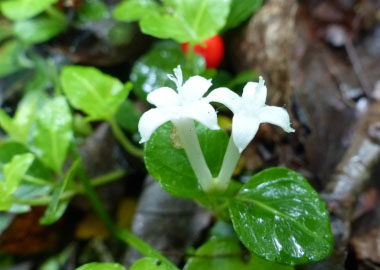
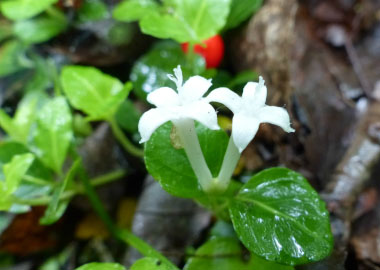
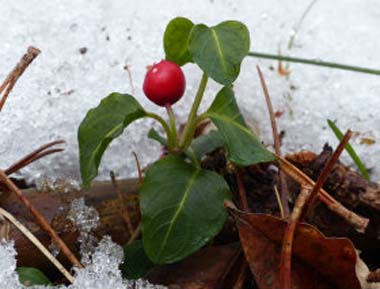
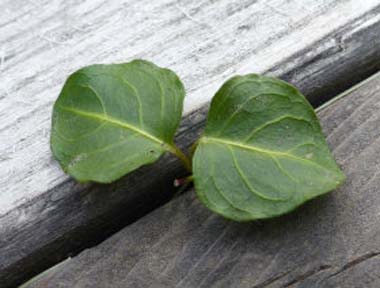
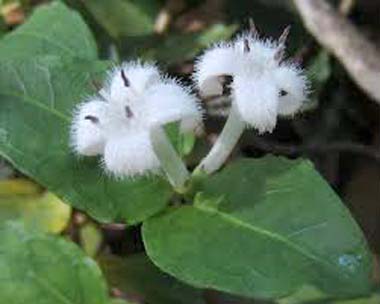
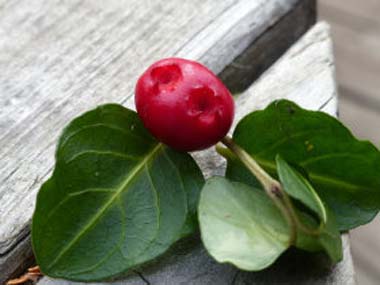
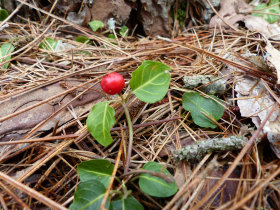
To support our efforts please browse our store (books with health benefits, etc.).
There is some confusion on the Internet in which the partridgeberry is known also as the lingonberry. Although both are edible, they are not the same plant despite the close resemblance. A partridgeberry’s ripe fruit forms from the pair of flowers therefore it shows the two markings on each berry, this is unique and distinctive. Partridgeberry is in the Madder family (Rubiaceae). It is distinguished from other woody vines by its small size, pairs of showy white flowers, and long-lasting red berries.
Distinguishing Features
This is a low trailing sub-shrub with fuzzy white flowers that grow in pairs forming one red berry per pair. The stems are mostly light green to light brown and either glabrous or hairy; old stems become brown, smooth, and woody.
Flowers
Pairs of upright flowers occur at the tips of branches or from the axils of leaves. Each flower has a hairy white corolla about 1cm long, 4 stamens, and a pistil with a single style. Each pair of flowers share the same short-tubular calyx. The flower is trumpet-shaped with 4 spreading lobes, while the calyx is light green with tiny teeth along its upper rim. The blooming period occurs from late spring to mid-summer and the flowers are fragrant.
 Fields
of Nutrition has medicinal benefits and vitamin/mineral content of Partridgeberry.
Fields
of Nutrition has medicinal benefits and vitamin/mineral content of Partridgeberry.
Leaves
Pairs of opposite leaves occur along the stems on short petioles up to ½ cm long. The leaves are ½ to 3cm long and similarly across; they are oval in shape and smooth to slightly undulate along their margins. The upper leaf surface is glabrous, shiny, and usually dark green. It is nearly white along the central vein and some of the lateral veins.
Height
Partridgeberry forms a low mat of evergreen leaves up to 10cm tall and 30cm or more across.
Habitat
Habitats include rocky upland woodlands, sandy savannas, slopes of wooded sand dunes, sandstone ledges along ravines, mossy boulders in wooded ravines, edges of red maple swamps, and bogs. This plant is found across a wide area of eastern North America.
Edible Parts
The leaves and berries are edible. Leaves are typically made into a tea. The berries can be used in any culinary dish although they taste rather bland. High in vitamin C, tannin, anthocyanins and antioxidants these berries have been known to play a huge role in our health including the prevention of certain forms of cancer.
Other Name
Twinberry.
Similar Plants
Lingonberry.
Winter Survival Food Handbook

PDF Plant Magazines
Types of Wild Food
Geographic Zones Seasons
Disclaimer
EdibleWildFood.com is informational in nature. While we strive to be 100% accurate, it is solely up to the reader to ensure proper plant identification. Some wild plants are poisonous or can have serious adverse health effects.
We are not health professionals, medical doctors, nor are we nutritionists. It is up to the reader to verify nutritional information and health benefits with qualified professionals for all edible plants listed in this web site. Please click here for more information.
Why Edible Wild Food?
- Food costs are rising
- Free, wild food is readily abundant
- Wild food adds nutrition to your diet
- Wild food can help treat various medical conditions







